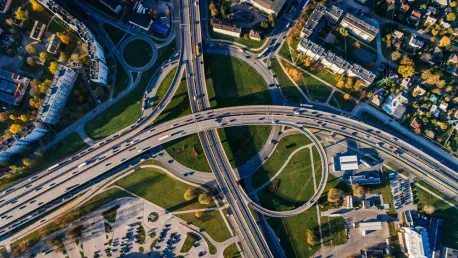The modern era demands a significant transformation in how societies manage mobility. Achieving sustainable transportation is essential for addressing environmental concerns and promoting healthier urban living. Implementing and reforming legal frameworks is a critical step toward achieving these goals. Various strategies and regulatory measures provide a comprehensive approach to sustainable mobility across different transportation modes such as road, rail, and aviation. Addressing these sectors through targeted legal instruments can help mitigate environmental impacts, improve public health, and foster a more equitable distribution of resources.
Transforming Urban Spaces for Sustainable Mobility
To achieve sustainable mobility, cities must undergo considerable transformations in their road spaces and parking policies. The reallocation of road spaces to prioritize public transport, cycling, and pedestrian areas is a foundational step. Changing parking policies to discourage extensive automobile use and promote alternative modes of transport can significantly alleviate urban congestion and pollution. These steps create more livable urban environments by reducing traffic and emissions, thereby enhancing public health and community well-being.Innovative solutions such as sustainable car-sharing models and well-designed public transport systems in rural areas contribute to the sustainable mobility transition. Car-sharing reduces the need for personal vehicle ownership, decreasing the number of cars on the road and promoting efficient use of shared resources. Additionally, expanding and enhancing public transport in rural areas ensure accessibility and mobility for all demographics, reducing dependency on cars and promoting environmentally friendly travel options.Public spaces in urban areas can be reclaimed for broader community use by strategically redesigning roadways and parking facilities. Green spaces, pedestrian zones, and dedicated cycling lanes help foster a more socially engaging and environmentally conscious urban landscape. Legal frameworks must, therefore, embrace urban planning principles that integrate sustainable transport strategies, ensuring that cities evolve into healthier, more vibrant places to live and work.
Regulating Air Traffic for Environmental Protection
Air traffic regulation is a critical component of sustainable mobility, particularly in minimizing noise pollution and safeguarding community health. Developing and enforcing flight procedures that prioritize noise reduction can significantly mitigate the environmental and health impacts on communities surrounding airports. Regulations need to strike a balance between operational efficiency, safety, and environmental considerations, requiring meticulous planning and legal oversight.The legal evaluation of flight procedures is essential in formulating policies that align with environmental goals. Flight paths, operational hours, and aircraft technology must be regulated to minimize noise and emissions. The synchronization of airport planning approvals with environmental regulations ensures that new developments or expansions do not compromise sustainability objectives, reinforcing the role of law in guiding environmentally sound aviation practices.Noise pollution from air traffic has long been a concern for communities near airports. Effective regulation requires collaboration between aviation authorities and environmental agencies to design flight paths and operational procedures that minimize noise. Furthermore, advancements in aircraft technology should be legally mandated to adopt quieter engines and more efficient designs. By embedding these requirements within legal frameworks, the aviation sector can significantly contribute to broader sustainability goals.
Incentivizing Cleaner Rail Transportation
Rail transport, while generally more sustainable than road or air travel, still poses environmental challenges, particularly concerning noise and emissions. Implementing noise-based track access charges is one effective strategy to incentivize replacing older, noisier freight wagons with quieter models. This economic incentive encourages rail operators to invest in newer, less disruptive technologies, reducing noise pollution and improving the quality of life for communities near rail lines.Installing particle filters in diesel locomotives can dramatically decrease air pollutants, ensuring that rail transport remains a cleaner alternative. Such technical adaptations need to be supported by comprehensive legal frameworks to ensure compliance and widespread adoption. Encouraging rail operators to adopt cleaner technologies through subsidies or tax incentives can accelerate this transition, contributing to an overall reduction in the transportation sector’s environmental impact.Railway infrastructure also requires investment to accommodate newer, cleaner technologies. Legal instruments play a pivotal role in mandating these upgrades and providing financial mechanisms to support them. Policies that promote research and development in sustainable rail technologies are essential. By establishing stringent emissions standards and rewarding compliance through financial incentives, legal frameworks can drive the rail sector towards more sustainable practices.
Utilizing User Charges for Environmental Commons
The exploitation of global environmental goods—such as oceans and airspace—requires careful regulation to manage traffic and encourage sustainable practices. Implementing user charges, such as tolls, fuel charges, and emissions-based fees, provides financial incentives to curb overuse and pollution. These charges can generate revenue to invest in sustainable technologies and infrastructure, promoting a cycle of continual improvement and environmental stewardship.Economic signals sent through user charges can prompt industries to adopt more sustainable practices, reducing greenhouse gas emissions and other pollutants. Properly designed and enforced user charges encourage efficient use of environmental resources, aligning economic activities with global sustainability goals. This approach of regulating global commons through financial mechanisms ensures that environmental protection remains a priority in economic and industrial planning.User charges are particularly effective in high-traffic areas like major shipping lanes and busy air corridors. By imposing fees based on the environmental impact, these charges not only control traffic volume but also incentivize the adoption of cleaner technologies. For instance, airlines and shipping companies may invest in more fuel-efficient engines or alternative fuels to reduce their operational costs. Thus, regulatory frameworks must be designed to equitably distribute these charges while ensuring they effectively promote sustainability.
Implementing Tax Measures to Promote Sustainable Mobility
Aviation has historically been under-taxed compared to other transport sectors, resulting in an imbalance that favors air travel despite its significant environmental footprint. Introducing an aviation ticket tax can rectify this disparity, encouraging a shift towards more sustainable travel modes. Such taxes ensure that the aviation sector bears a fair share of environmental costs, aligning it with broader sustainability efforts.Reducing VAT rates for rail transport, particularly long-distance services, makes train travel a more attractive and affordable option. This tax incentive can level the playing field between rail and air transport, leading to increased market share for railways. Encouraging the use of rail transport over aviation through fiscal measures supports the broader goal of reducing transportation emissions and promoting sustainable travel.Fiscal policies must also consider the broader socioeconomic impacts of these tax measures. For instance, reduced VAT rates on rail travel can make this mode of transport more accessible to a larger segment of the population. In contrast, aviation taxes should be designed to minimize the financial burden on essential travel. Balancing these considerations within legal frameworks ensures that the economic incentives for sustainable mobility do not disproportionately impact specific groups while achieving environmental goals.
Enhancing Urban Quality of Life Through Speed Limits
In today’s world, there is a pressing need for significant changes in how societies handle mobility. Sustainable transportation is vital for tackling environmental issues and encouraging healthier urban lifestyles. Reforming legal frameworks and implementing new regulations are crucial steps toward reaching these objectives. A variety of strategies and regulatory measures can offer a comprehensive approach to achieving sustainable mobility across various transportation modes like roadways, railways, and aviation.Addressing these sectors with targeted legal tools can help lessen environmental harm, enhance public health, and ensure a fairer allocation of resources. For instance, stricter emissions standards for vehicles can reduce air pollution, while improved public transportation infrastructure can decrease reliance on personal cars, thus lowering traffic congestion and reducing greenhouse gas emissions. Additionally, advancing technologies such as electric vehicles and high-speed rail can further support the shift toward sustainable transportation.Moreover, policies promoting active transportation, such as biking and walking, contribute to both environmental sustainability and public health. Urban planning that incorporates green spaces and pedestrian-friendly areas can significantly improve residents’ quality of life. By modernizing our transportation systems through thoughtful legal reforms and innovative strategies, we can create a more sustainable and equitable future.









